The Big Office Move Checklist

So, you’re moving office? Perhaps you need more office space? Maybe you’re just after a more professional set up? Either way, you’ll be keen to minimise the stress to your staff and disruption to your workflow. Although it’s an exciting process, moving your business can still be complicated and expensive.
That’s where we come in. We’ve put together the comprehensive four-step office relocation plan – NOMA – to get your business settled sooner.
- Who to notify
- What to organise
- Moving Checklist
- Final details
Our guide will provide you with all the steps, as well as some handy tips, to make your move as easy as possible.
Let’s get started.

Step 1: Notify customers, clients and employees
First things first, you need to make sure the people most affected by your move all know that you’re moving and to where.
The notifying process is meant to ensure that all the people crucial to your business, including customers, clients and employees are kept right up-to-date with your plans to move. Remember to provide them with all the relevant details for them to stay connected with your business, including your new phone number and address.
Here’s who you need to tell when you’re moving office.
Landlord
Notify your current landlord of your intention to vacate the old office premises, providing them with due notice of the event.
You should check your contract for the notice period you are required to provide. You also need to begin checks of general office wear and tear at this stage to make sure you are aware of any repairs or replacements that you may be required to make.
Suppliers
Notify your current suppliers and partners — for example, your accountant, IT support, courier and so on — that you’re moving.
Some suppliers might ask you to give them a certain amount of notice so plan this well in advance.
Customers
Notify your customers and clients of the change of your address. A multi-platform announcement —including social media posts and emails — is a good start and can help ensure that your customers remain in the know.
Staff
Last but not least, don’t forget to notify the people at the heart of your business: your employees. It may sound obvious, but your staff will benefit from knowing where they are moving to as early as possible. The earlier they know, the more support they can also provide throughout the process. They’ll also be able to better organise their own personal and work schedule.

Step 2: It’s time to organise
Once your customers, clients and colleagues know your plan, it’s time to start organising your move. Set aside plenty of time for this – it’s the biggest part of the job, and there’s always more work than you think!
This part of the process is where you ensure the move goes as smooth as possible.
New premises
Organise access to your new premises for all relevant parties, including staff and other service providers.
This step could, of course, mean a variety of different things depending on the security you are organising for your new office. If you are using traditional keys, we recommend getting several keys cut for key members of staff. If you are using electronic keys, get them set up before your move so you can issue them all on day one.
Inventory
Whether it’s data to be collated and stored, office furniture to be dismantled or waste to be removed, now is the time to take stock of what you have, what you need, and what you can leave behind.
Shopping list
Moving office gives you the opportunity to change the way you present your business. You could use this opportunity to upgrade your decor or invest in new furniture. This can help you maximise the benefits of your new space.
Cleaning services
When you leave your current office, it’ll need to be cleaned so it’s in good nick for the landlord. We recommend that you hire a professional cleaning service for this step to ensure a smooth end to your current tenancy.
Health and safety
It’s important all your necessary documentation and signage is, at a minimum, ordered and, ideally, ready for installation before your move. Precisely what you need will vary from business to business but there are a few core bits and bobs that most offices will need.
Have you got the necessary fire safety signage? Have the potential trip hazards been identified and steps taken to minimise their risk? It’s also worth contacting your landlord to establish what exactly is already in place and what you may need to update or change.
Connectivity
Before your move, you should contact phone, internet and networking providers to arrange installation in your new office. Since these services are essential to your business, it’s crucial that they’re up and running as soon as possible.
While internet connections and office networks are pretty simple, moving the phone number over is usually a bit trickier.
Removals
For an office move, it’s pretty important you arrange a removals company. Well, unless you like carrying dozens of boxes to and from your car. Don’t scrimp on hiring either as a good company is worth its weight in gold.
Do your research beforehand, checking prices, availability, haulage capacities and insurance. You may also want to provide them with additional material, such as a floor plan, to make the moving process easier.
Timetables
If you fail to prepare, you should prepare to fail! Creating a moving timetable might seem like overkill but it’ll provide some much-needed structure to your day. A timetable doesn’t have to be overly rigid and should allow for the odd hiccup throughout the day.
The more work you do during the organisation stage, the easier the moving process is. Not only is it easier for you, but it will make the process easier for you, your staff and other parties.

Step 3: Move Day Checklist
Your big move day has arrived. By now, everybody should be aware of the plan for the day. The important thing for you is to be accessible throughout the day, helping your staff and your external support. Whether you’re directing movers, motivating your staff or coordinating with external service companies, your role on the day is crucial for everything to go off without a hitch.
Access
Ensure that all the relevant parties — employees, movers, cleaners and so on — have access to your new and old premises. If your removals company has to hang around for an hour waiting on someone with a key, you can say goodbye to your perfect moving schedule.
Also, think about digital access too. If you’ve got an IT provider installing services, make sure they have all the login details they need.
Test everything
Make sure your IT systems, telephone systems and other necessary services are operating as required to help you hit the ground running. Testing now is much more efficient rather than confronting a temperamental internet connection when you and your staff are already working in your new office.
Stay positive
Create a positive, supportive working environment for all the team members involved – whether it’s something as simple as ensuring the air-con is on for the movers, or something bigger like laying on refreshments.
Office moving day is inevitably exhausting. Your role on the day is to be the project manager. Make sure you are accessible so that both external companies and your staff can contact you with queries. Providing support is also crucial. Never underestimate the importance of team morale on the big day. It should be exciting, a fresh opportunity for you, your staff and your company so make sure everyone can feel that excitement coming from you!

Step 4: Final details
After all the hard work, now is the time to enjoy your new office space. There are just a couple of small details left to arrange after moving day.
Deep clean
Moving is always messy, with cardboard boxes, plastic wrapping, and polystyrene everywhere. You’re going to want to make sure your new office is in top condition, so it may be worth hiring in additional cleaners to get the new place in pristine condition.
Settle your bills
Finalise your business with any external companies used in the moving process. If your moving company has provided a high-quality service, take the time to ensure your bills are settled and leave positive feedback. (They might even cut you a deal next time.)
Solicit feedback
An office move is as big a move for your staff as it is for you. Find out how the process was for them, what worked, and what they didn’t like so much. It’s important that their views are heard. Plus, you’ll learn a tonne for your next move.
Go the extra mile
Go the extra mile to make your staff feel at home. You could flex your creativity here and come up with a welcome pack or guide for your staff in recognition of their help in the moving process.
Celebrate your move
You should already have informed customers and clients of your move but now is the time to remind them. If you are active on social media, your new office is a great opportunity for creative content. Perhaps a tour of the new office?
And finally, celebrate! Moving is hard work, so make sure you reward your staff (and yourself) once you’re settled in by throwing a moving in party.
You did it!
Congratulations! You’ve made it! Office moves are stressful and expensive, but we think four easy steps are all it takes to get from the old to new. So, if you’re thinking of moving offices soon, just remember NOMA: Notify, Organise, Move and Afters. Did we miss anything? Tell us your experiences below.
If you think your new office would benefit from a bit more space, Storage Vault is on hand to help. We’ve got a number of self-storage facilities dotted throughout Scotland that are perfect for space-strapped businesses. Check out our specialised Business Storage service.
Get in touch





